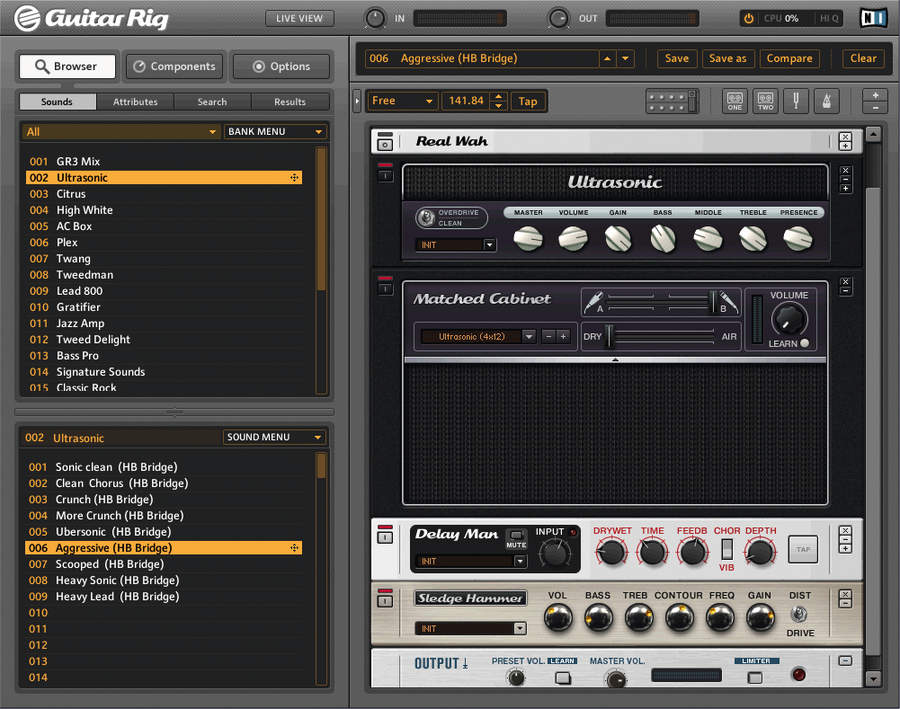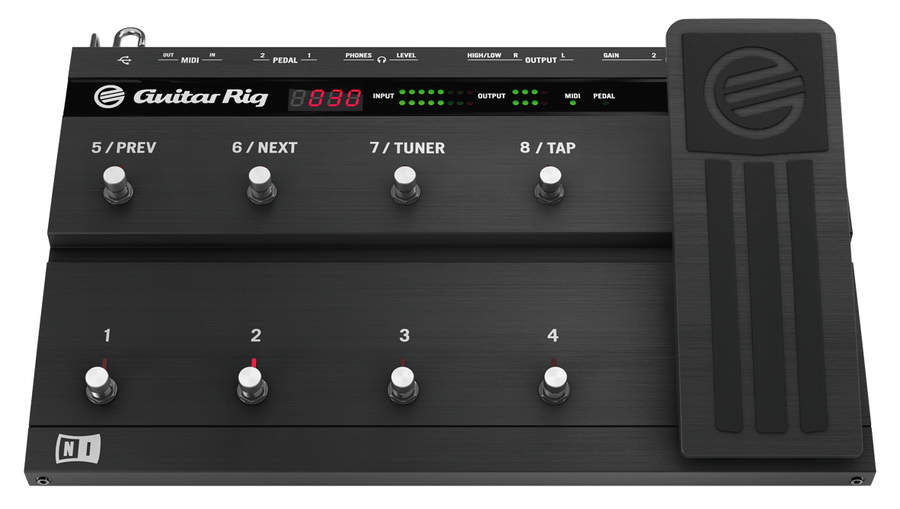MusicRadar Verdict
Guitar Rig 3 offers instant tonal gratification and is a viable option for live use. Great stuff.
Pros
- +
New amps and stompboxes are great. High-gain sounds are particularly good. Easier to use than version 2. Useful LED lights on Rig Kontrol.
Cons
- -
No balanced mic input. Still very processor-hungry.
MusicRadar's got your back



While most were more than happy with NI's Guitar Rig 2, there were still a few niggles. Although the list of amps was impressive, there were gaps when trying to nail a subtly driven but undistorted tone.
At the other end of the spectrum, there wasn't much choice for raging, high-gain sounds.
The first thing that you notice about GR3 is that it looks cleaner. The GUI has been given a lick of paint and the tiny-fonted, light-brown-on-brown browser has been replaced by a larger font and a white-on-black display.
What every Guitar Rig user has been eagerly drooling over, though, is the set of new modules. With four new amp models and six new effects units, there are now very few holes in this amp package.
Amps
The first addition is Citrus, which is modelled on the classic Orange amps. It does an excellent job of recreating the warm distortion found on vintage rock records, and, more recently, those of Noel Gallagher.
There's also the Hi-White, which is great for aggressive yet clean tones, demonstrated by the 'Pete Can't Explain' preset.
The delightful Tweed is based on a classic Fender model and delivers a pure and full-bodied tone - a perfect base for the more blues-friendly distortion units.
Finally, there's the Ultrasonic; this is something that'll keep high-gain junkies happy, as it delivers thick, heavy sounds that make it easy to emulate modern metal tones.
What helps make these new amp models such a success is the addition of a Matched Cabinets feature. While flexibility is desirable, GR2 was guilty of giving us too much to think about regarding things like mic placement and cabinet EQ.
The new feature automatically gives you a well-matched cab that suits the tone of the amp to which it is paired, although the old method is still available for those who like to tinker.
Effects
The new effects take the total up to a stunning 44! There's now a ring modulator, vintage-style EQ, delay with built-in chorus and vibrato, and the bone-crushing Sledgehammer distortion.
Perhaps the most appealing new effect, though, is the tasty Tape Echo, which is a dead ringer for the classic Roland Space Echo. Native Instruments even mention on the unit's info panel how proud they are of this, and with good reason. It has two 'tape' heads and a reverb section, and a suitably warm, vintage sound.
Foot controller
The Rig Kontrol foot pedal/audio interface has also been given an overhaul. The sound quality has been improved (it's now 24-bit/192kHz) and the converters are now the same as those used in NI's Audio Kontrol 1.
The Rig Kontrol 2 had a few minor functionality issues, but these have now been sorted. Previously, the only indicator of the input level was a barely visible LED that indicated clipping.
There are now separate input and output LEDs that shine in glorious green, making them impossible to miss, even in the murkiest of live venues.
Notably, there's much more consistency in the way the software functions are mapped to the individual switches of the Rig Kontrol, unlike previous versions where presets could differ a fair bit in the way they mapped the switches.
There remain a couple of gripes, though. There's still no output volume knob, only a pad switch. This means you have to set the volume level in software, which can be a pain.
Also missing is an XLR input. While the Rig Kontrol is aimed at guitarists and space on the back of the unit is sparse, it's supposed to be the only interface anyone needs, so it could be a disappointment for those wanting to hook up a mic too. For guitarists who sing, an XLR input would have made GR3 a one-stop solution to their gigging needs.
In summary
So has NI reached perfection with this version? Well, it's still really processor-hungry, so it can be tricky to keep the latency low if you're running more than one or two other plug-ins as you record.
What's more, Rig Kontrol is still a compromise as far as using it as a dedicated audio interface goes; it has to sit on the floor, which makes it awkward to adjust input levels, and you'll have to run cables from your playing position, which can be messy.
However, these are minor points, and the new amps and effects mean that pretty much all tonal bases are now covered.
But does it sound as good as the real thing? We can confirm that it does, and this is borne out by the number of big-name players who are already in love with Guitar Rig.
Purists may scoff that it doesn't sound the same as hardware, but we feel this is a redundant argument. The range of high-quality tones available makes this an awesome and essential creative tool.
MusicRadar is the number 1 website for music makers of all kinds, be they guitarists, drummers, keyboard players, djs or producers...
GEAR: We help musicians find the best gear with top-ranking gear round-ups and high- quality, authoritative reviews by a wide team of highly experienced experts.
TIPS: We also provide tuition, from bite-sized tips to advanced work-outs and guidance from recognised musicians and stars.
STARS: We talk to musicians and stars about their creative processes, and the nuts and bolts of their gear and technique. We give fans an insight into the actual craft of music making that no other music website can.
"I didn't know you could change the tempo in Pro Tools, so I just made all my songs at 120bpm": Super-producer Benny Blanco reveals the surprising reason why most of his early hits are the same tempo
The Curse of Coachella: Bad sound, bad gigs and even worse audiences - Is Coachella now the worst festival in the world?
“FORMAL CHARGES OF OVERPLAYING": Zak Starkey has been sacked from The Who










